Abstract
Background: With the growing trend of ageing, there is an urgent need for effective interventions that enhance positive psychological functions among older adults. Objective: (1) To evaluate the effectiveness of life review and reminiscence therapy in enhancing the quality of life and life satisfaction among older adults. (2) To discover efficacious variables during interventions, such as form of intervention and number of sessions. Methods: Relevant randomized controlled trials in both English and Chinese languages were searched across eight databases. The meta-analysis was conducted by a random effects model using STATA 17. The registration number of this review is CRD42023424085. Results: Thirty-two studies with 2353 participants were included. Experimental groups of older adults significantly improved their quality of life (SMD 1.07; 95% CI 0.48 to 1.66; p < 0.001) and life satisfaction (SMD 1.12; 95% CI 0.63 to 1.60; p < 0.001). Subgroup analyses revealed that individual sessions of life review and reminiscence therapy had a more significant impact on improving quality of life and six to eight intervention sessions could enhance life satisfaction more effectively. Conclusions: Life review and reminiscence therapy hold promise for application in medical and nursing care for older adults, suggesting the potential benefits of implementing intervention designs with effective settings for positive psychological functions.
1. Introduction
With life expectancy increasing, the proportion of individuals aged 60 and over is growing at a faster pace compared to any other age group. By the year 2030, it is forecast that approximately one-sixth of the global population will be individuals aged 60 years or older; by 2050, the global population of individuals aged 60 years and older will have doubled, reaching a count of 2.1 billion [1]. Therefore, ageing is becoming an inevitable global demand that requires more effective solutions across various living settings. In 2002, the World Health Organization adopted “active ageing” as a response to the challenges posed by population ageing [2]. As a multidimensional concept, active ageing is evaluated using a combination of objective and subjective indicators [3]. This process aims to optimize opportunities for health, participation, and security to enhance the quality of life as people age [2]. Consequently, as a state of being, quality of life would be a fitting objective indicator for assessing active ageing. Moreover, life satisfaction, as a fundamental dimension of subjective well-being, is evaluated from both the experience of pleasure and contentment with one’s own life. Thus, it would be an appropriate subjective indicator to assess the process of active ageing [4].
As individuals progress in age, the connection between psychological states and health grows increasingly significant [5]. In order to enhance the positive psychological functions of older adults, a range of psychological interventions has been extensively implemented across various living environments. After Robert Butler [6] initially introduced the concepts of life review and reminiscence as tools to help older adults comprehend their current circumstances by establishing connections with past experiences, life review and reminiscence therapy were developed and are currently widely employed as interventions in the care of older adults across various illnesses and settings, including nursing homes and hospitals [7]. Because of their shared theoretical foundations, the terms life review and reminiscence therapy are frequently employed interchangeably in interventions. Consequently, the synthesis of evidence from life review and reminiscence therapy among older adults assumes particular significance [8].
Up until now, a range of studies have supported the effectiveness of life review and reminiscence therapy in treating various psychological problems as cost-effective, non-pharmacological interventions with minimal side effects [9,10]. In a Bayesian network meta-analysis, the findings indicate that life review emerges as the best-ranked intervention for relieving anxiety and distress in an inpatient palliative care setting compared to three other short-term psychological interventions (cognitive behavioral therapy; mindfulness intervention; action control group) [11]. Moreover, another meta-analysis supports the idea that reminiscence therapy effectively improves cognitive function and alleviates depression in people with dementia (p < 0.001) [12].
However, the positive psychological outcomes associated with life review and reminiscence therapy lack consistent conclusions. A meta-analysis including 22 studies and 1972 participants revealed no statistically significant effect of reminiscence therapy on quality of life (p = 0.16) [13]. Moreover, another meta-analysis indicated no significant difference in the observed improvement in life satisfaction between the life review group and the control group (p = 0.14) [14]. Recently, two systematic reviews have concluded that reminiscence therapy is effective in improving quality of life and life satisfaction among the elderly in the community or older adults with intact cognition and mild cognitive impairment [15,16]. Nevertheless, the living environments and health statuses of older adults vary significantly. Therefore, there is an urgent need for a comprehensive quantitative assessment of intervention effectiveness, considering the varied living conditions of older adults and their diverse health statuses.
In summary, a lack of consistent findings regarding the efficacy of life review and reminiscence therapy in different settings in positive psychological outcomes exists, potentially impeding the optimal allocation of care resources. Consequently, to promote the process of active ageing, the objectives of this meta-analysis are to evaluate the effectiveness of life review and reminiscence therapy on the quality of life and life satisfaction of older adults, while also discovering the potential efficacious variables related to the settings.
2. Methods
This review was conducted following the Preferred Reporting Items for Systematic Review and Meta-Analyses (PRISMA) guidelines [17]. The review protocol was registered with PROSPERO (registration number CRD42023424085) [18].
2.1. Search Strategy
We conducted a systematic literature search on 17th March 2023 across eight databases, including Web of Science, EBSCO, Embase, The Cochrane Library, ProQuest Dissertations & Thesis Global, WANFANG, VIP, and CNKI (the latter three were used for Chinese studies), which were established in 1997, 1944, 1988, 1993, 1743, 1993, 2000, and 1999, respectively. There were no restrictions regarding the publication date. Only studies in English or Chinese were reviewed in this meta-analysis. Both published articles and peer-reviewed dissertations were included. The following search terms were used: (reminiscence* OR “life review*” OR nostalgia*) AND (intervention* OR treatment* OR therapy* OR program*) AND (elderly* OR “old people” OR “older adult*” OR “the aged” OR “late life”). The search terms are created by Boolean logic retrieval. Additionally, the reference lists of eligible review articles were also considered.
2.2. Study Selection
The retrieved articles were imported into EndNote version 20 software to remove duplicates and subsequently imported into Rayyan (https://rayyan.ai (accessed on 17 March 2023)) for screening. Two authors (Q.Z. and C.C.) first screened the studies for initial inclusion based on titles and abstracts after excluding duplicates. The same two authors then independently identified studies meeting the inclusion criteria based on the full-length text. Any discrepancies between the two authors during the literature screen and full-text review were resolved through discussions with the third author (S.L.C.). The inclusion criteria were as follows: (1) older adults aged 55 years and above; (2) life review or reminiscence therapy as the intervention; (3) randomized controlled trials (RCTs) as the study design; (4) one or a combination of the two outcomes: quality of life and life satisfaction; (5) if the data were published repeatedly, studies reporting the data in more detail were included. The exclusion criteria were as follows: (1) non-research articles: conference articles and reviews; (2) unable to obtain the full text; (3) no sufficient information for computing effect sizes.
2.3. Data Extraction
After screening all studies, records of included studies were saved in Excel. A data charting form for recording relevant information was created and pilot-tested by the review team. Two reviewers (Q.Z. and C.C.) used the initial draft of the data charting form to code data and then revised the coding form based on a discussion with the review team. Two trained coders (Q.Z. and C.C.) independently completed the final coding form for each eligible paper. If there were differences in the coding of specific items, the third author (S.L.C.) would make the final decision. Studies were coded by methodological characteristics, including first author, year of publication, country, age, the proportion of females, sample size, health condition, intervention details (e.g., intervention types and intervention conductors), the frequency and duration of each intervention session, the length of the intervention given, the post-intervention follow-up period, and outcomes. If the article data contained SE, the formula (SE = SD/√n) was used to convert the data to SD. Authors were contacted via email if any data were missing from the study.
2.4. Quality Assessment
The risk of bias in the included articles was assessed by two reviewers (Q.Z. and C.C.) according to the criteria recommended by the Cochrane Handbook using the Cochrane risk-of-bias tool (RoB2) [19]. This tool assesses bias arising from (1) the randomization process (including random sequence generation and allocation sequence concealment); (2) intervention deviation (blinding of participants and personnel); (3) missing outcome data (risk of bias of the data and results calculation); (4) measurement of outcomes (risk of bias of the assessment methods); and (5) selection of results (risk of bias in selection of the reported result). Each of these domains is ranked for risk of bias as ‘low’, ‘some concern’, or ‘high’, with an overall assessment of study quality compiled. The results of the quality assessment were documented in Excel.
2.5. Data Synthesis and Analysis
Statistical analysis was conducted using STATA/MP software version 17.0. The adjusted mean difference (Hedges’ g), which could provide a more conservative estimation with small sample sizes, was used as the outcome statistic, and 95% confidence intervals were computed. The true difference between studies would affect the measurement of study variability, so analyses of impact sizes were undertaken with random effect models. The I2 statistic was utilized to evaluate the level of heterogeneity, with values of 25%, 50%, and 75% representing low, medium, and high levels of heterogeneity, respectively. Sensitivity analysis was performed to assess the influence of each individual study by systematically removing each study one at a time. To identify the factors contributing to heterogeneity (I2 ≥ 50%), subgroup analyses were conducted with Review Manager 5.4, incorporating three variables: form of interventions, total sessions of interventions, and types of comparison. Additionally, as a continuous variable, the year of publication was evaluated by meta-regression. To assess the presence of publication bias, the visual assessment of the funnel plot and Egger’s regression intercept were undertaken, if ten or more studies were included.
3. Results
3.1. Study Selection
A total of 4196 records were identified from eight databases. In addition, 33 relevant articles were identified from the reference lists of relevant reviews and selected articles. After removing the duplicates, the total number of records was 2401. Subsequently, 2278 records were excluded after the title and abstract screening, and the remaining 171 records were evaluated by the full texts. Finally, 139 studies were excluded based on the inclusion criteria and the remaining 32 studies were selected for inclusion in the final meta-analysis. The selection flow was presented in the PRISMA flowchart (Figure 1).
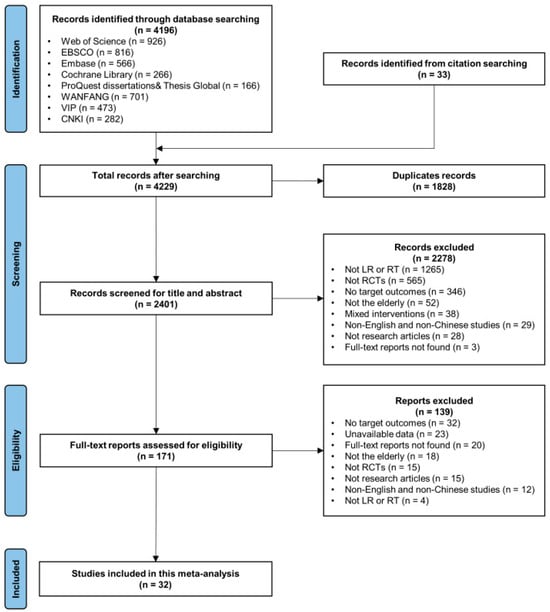
Figure 1.
PRISMA flow chart.
3.2. Study Characteristics
Among the 32 articles included in the meta-analysis, 37 RCTs involving 2353 older adults were conducted. The sample sizes ranged from 12 to 202 participants per study, and all of them comprised both male and female individuals. Specifically, females accounted for 62.79% of the total sample size. In this study, 37.44% (n = 881) of participants were diagnosed with different types of dementia and cognitive impairment; and 17.42% (n = 410) with psychological symptoms, including depression and anxiety. Furthermore, 13.34% (n = 314) of the participants were stroke patients; 5.48% (n = 129) with frailty; and 5.10% (n = 120) had chronic diseases.
Among the studies included in the analysis, fifteen were conducted in China, five in the United States, two in the United Kingdom, and one study each was conducted in Iran, Ireland, Japan, the Netherlands, Northern Cyprus, Portugal, Spain, Switzerland, and the Dominican Republic. Most of the included interventions (n = 21) were conducted in institutions such as hospitals, nursing homes, and day-care centers; only a few (n = 4) were conducted at home. Interventions were conducted by therapists (n = 11), researchers (n = 11), and nurses (n = 6). Life review and reminiscence therapy were implemented for varying durations, ranging from four weeks to thirteen weeks, and 30 min to 120 min for each session, with the majority consisting of eight weekly sessions. Most studies employed life review and reminiscence therapy by discussing specific themes, such as childhood experiences. Furthermore, meaningful items, such as photographs, songs, foods, or letters, were utilized as clues during the therapy sessions. Study characteristics are presented in detail in Table 1.

Table 1.
Study characteristics.
3.3. Risk of Bias
In terms of risk of bias (Figure 2), 80% of the included studies were rated as some concerns, and 10% were rated as low risk and high risk, respectively. As only RCTs that provided valid data were included in this meta-analysis, the risk of randomization bias (100%) and results reporting bias (90%) were both low. However, given that the two outcomes in this study were assessed through self-assessment scales, there were potential concerns and risks regarding deviations from intended interventions (65%) and the measurement of outcomes (80%).
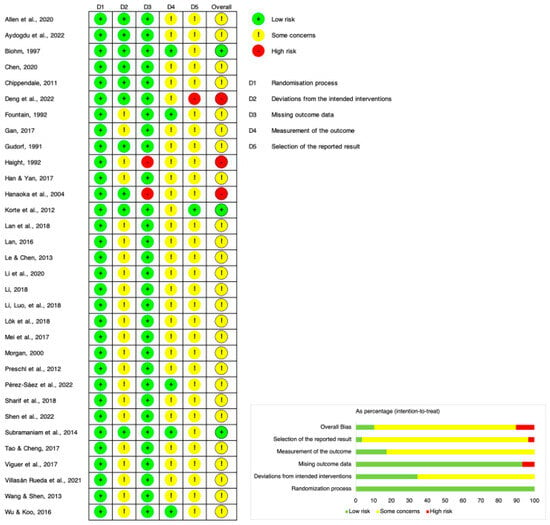
Figure 2.
Risk of bias graph [20,21,22,23,24,25,26,27,28,29,30,31,32,33,34,35,36,37,38,39,40,41,42,43,44,45,46,47,48,49,50,51].
3.4. Main Outcomes
3.4.1. Quality of Life
Fifteen RCTs, involving 1280 participants, reported the effects of life review and reminiscence therapy on quality of life using the Quality of Life in Alzheimer’s Disease (Qol-AD) [27,37,39,42,45,46,47], the Control, Autonomy, Self-realisation and Pleasure Quality of Life questionnaire (CASP-19) [20], the Dementia Quality of Life (DQoL) [50], the Euroqol questionnaire (EQ-5D) [32], the Generic Quality of Life Inventory-74 (GQoLI-74) [25], the Karnofsky Performance Scale (KPS) [36], the 36-item Short-Form (SF-36) [38], the World Health Organization Quality of Life Questionnaire (WHOQOL_BREF) [44], and the World Health Organization Quality of Life (WHOQOL-100) [23]. The forest plot (Figure 3) showed a significant effect of life review and reminiscence therapy for improving quality of life among older adults (SMD 1.07; 95% CI 0.48 to 1.66; I2 = 95.50%; p < 0.001).
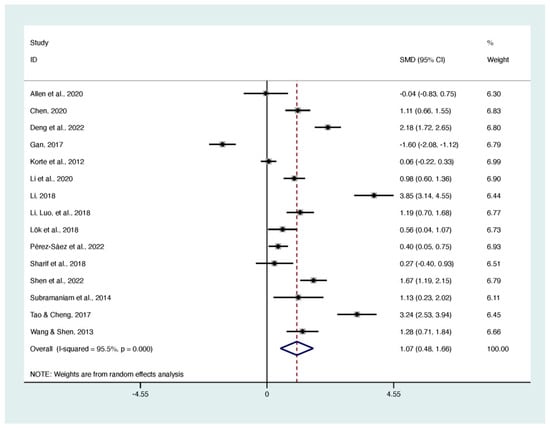
Figure 3.
Forest plot of the effect on quality of life [20,23,25,27,32,36,37,38,39,42,44,45,46,47,50].
3.4.2. Life Satisfaction
Twenty-two RCTs, involving 1098 participants, examined the effects of life review and reminiscence therapy on life satisfaction using the Life Satisfaction Index-A (LSI-A) [21,22,24,29,30,31,33,34,35,41,43,48,49,51], the Satisfaction With Life Scale (SWLS) [20,40], the Life Satisfaction in the Elderly Scale (LSES) [28], and the Revised Philadelphia Geriatric Center Morale Scale (RPGCMS) [26]. The results showed that significant standardized mean differences existed in life review and reminiscence therapy compared with controls for life satisfaction (SMD 1.12; 95% CI 0.63 to 1.60; I2 = 91.90%; p < 0.001) (Figure 4).
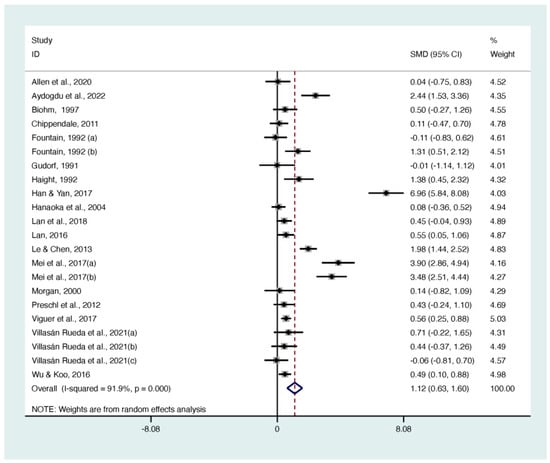
Figure 4.
Forest plot of the effect on life satisfaction [20,21,22,24,26,28,29,30,31,33,34,35,40,41,43,48,49,51].
3.5. Sensitivity Analysis
Due to high heterogeneity, two sensitivity analyses were conducted to examine the potential outliers in the analyses of quality of life and life satisfaction. According to the results (Figure 5) for quality of life, Gan [27] and Li [36] were removed individually, and the effect size was significant, but heterogeneity was still high (SMD 1.26; 95% CI 0.74 to 1.78; I2 = 93.70%; p < 0.001; SMD 0.88; 95% CI 0.33 to 1.42; I2 = 94.50%; p < 0.001). The results for life satisfaction are similar (Figure 6); after removing Han et al. [30], the difference was significant, although heterogeneity remained high (SMD 0.85; 95% CI 0.48 to 1.22; I2 = 85.50%; p < 0.001).
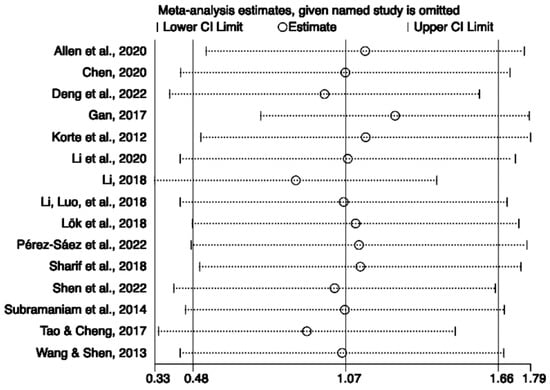
Figure 5.
Sensitivity analysis of the included studies on quality of life [20,23,25,27,32,36,37,38,39,42,44,45,46,47,50].
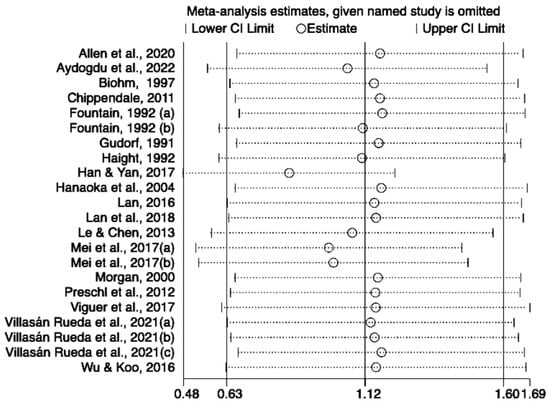
Figure 6.
Sensitivity analysis of the included studies on life satisfaction [20,21,22,24,26,28,29,30,31,33,34,35,40,41,43,48,49,51].
3.6. Meta-Regression and Subgroup Analysis
Meta-regression and subgroup analysis were then conducted respectively for continuous variables and categorical variables to investigate the potential drivers of heterogeneity.
3.6.1. Quality of Life
The meta-regression analysis revealed that the publication year of the studies was unable to explain the heterogeneity (p = 0.65). However, a significant difference (p = 0.006) was found in the subgroup analysis concerning the form of interventions (Table 2). Specifically, the subgroup analysis indicated that implementing life review and reminiscence therapy in a group setting did not yield a significant effect size on quality of life (SMD 0.18; 95% CI −0.15 to 0.52; I2 = 34.40%; p = 0.28). Furthermore, no significant differences were found in terms of the effect of the number of intervention sessions on quality of life among older adults (p = 0.71). Since only one study implemented no treatment as a control group, we were unable to assess the effects of different comparison groups for quality of life.

Table 2.
Subgroup analyses of quality of life.
3.6.2. Life Satisfaction
According to the meta-regression analysis, the publication year of the studies did not significantly contribute to the heterogeneity of the life satisfaction analysis (p = 0.28). In the subgroup analyses (Table 3), there were no significant differences in the form of interventions (p = 0.69) and the type of comparisons (p = 0.06) on life satisfaction among older adults. However, there was a significant difference in the number of intervention sessions on life satisfaction (p = 0.006). The findings indicated that there was no significant improvement in life satisfaction when the intervention was implemented in more than eight sessions (SMD 0.44; 95% CI 0.10 to 0.77; I2 = 37.50%; p = 0.14).

Table 3.
Subgroup analyses of life satisfaction.
3.7. Publication Bias
A visual examination of the funnel plot for the included studies revealed an asymmetry in both quality of life (Figure 7) and life satisfaction (Figure 8). However, Egger’s regression intercept analysis indicated the absence of publication bias for quality of life (p = 0.13), while publication bias was detected for life satisfaction (p = 0.045).
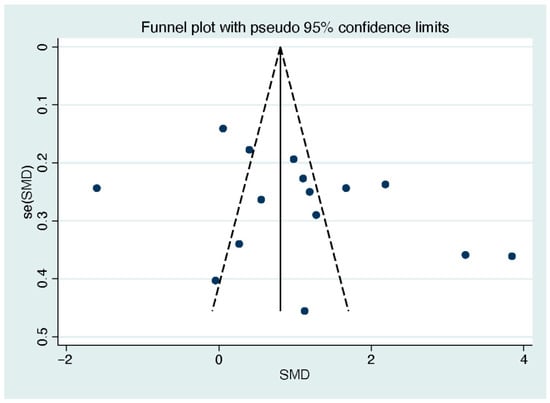
Figure 7.
Funnel plot of the included studies on quality of life. Note. Each data point within the graph corresponds to an included study.
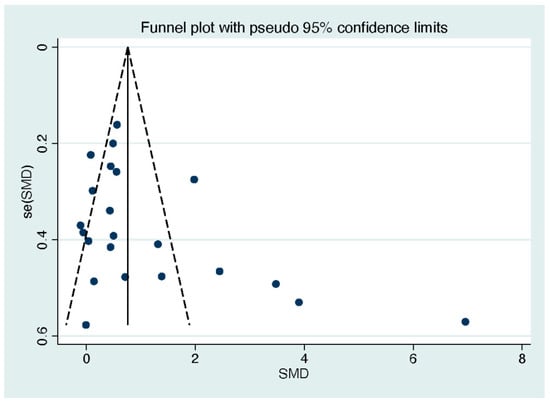
Figure 8.
Funnel plot of the included studies on life satisfaction. Note. Each data point within the graph corresponds to an included study.
4. Discussion
4.1. Main Findings
This meta-analysis revealed significant improvements in the quality of life and life satisfaction of older adults after receiving life review or reminiscence therapy, compared to the control groups. Consequently, implementing these two interventions in care and medical contexts holds promise for effectively promoting active ageing and yielding potential benefits for both individuals and societies. As for the long-term effect of life review and reminiscence therapy, five studies reported the results of quality of life four weeks (n = 2), six weeks (n = 1), and twelve weeks (n = 2) after the completion of the interventions. Acquiring a sufficient amount of follow-up data for research involving older adults poses a challenge. Consequently, due to the limited number of studies and the wide range of time periods employed, the studies included did not evaluate the long-term impact of life review and reminiscence therapy on quality of life. As for life satisfaction, 10 of 22 trials conducted a repeated evaluation at four weeks (n = 2), five weeks (n = 1), six weeks (n = 2), twelve weeks (n = 4), and forty-eight weeks (n = 1). The results showed that the effect of life review and reminiscence therapy on life satisfaction remained statistically significant even after 12 weeks following the completion of the intervention (SMD 1.59; 95% CI 0.39 to 2.80; I2 = 94.9%; p = 0.01). This result reminds us that incorporating reminiscence-based therapy alongside a comprehensive caring program could stimulate and sustain a positive mood among older adults, which could be beneficial to process active ageing.
However, a high level of heterogeneity was observed in the analysis of the results. Sensitivity analysis indicated the presence of outliers in the reporting of findings by certain studies. For instance, Gan [27] reported a significantly higher quality of life in the experimental group compared to the control group, contrary to what the data indicated. This reminded us to carefully assess the plausibility of data when selecting studies. Moreover, the variation in the results could be attributed to different interpretations of the outcome concept. Quality of life is a multifaceted variable, leading to different definitions and consequently varied measurement tools [52]. Because of the diversity of cultural backgrounds and social customs across various countries and regions, the applicability of a single scale to all situations is not feasible [53]. For instance, while the SF-36 is a widely used health-related survey [54] and is more suitable for elderly people in the community, the WHOQOL-100 places greater emphasis on individuals’ subjective perceptions of their life circumstances within the culture and values that shape their existence [55] and is mainly used for patients with Alzheimer’s disease and cancer. In conclusion, as previously elucidated, the differences in study design or measurement tools may contribute to the heterogeneity observed in the analysis of the results.
4.2. Implications for Future Studies
Subgroup analyses revealed that the impact on quality of life was influenced by the intervention setting. Specifically, when life review or reminiscence therapy was conducted in a group setting, the effect was not statistically significant. Additionally, another review also reported that individual sessions of reminiscence therapy are associated with benefits for cognition and mood among people with dementia [13]. However, Xu et al. [56] discovered that the effect size of individual reminiscence therapy was smaller compared to that of group sessions among older adults without obvious cognitive impairment. Researchers have suggested that a patient-centered intervention could be beneficial for people with dementia [7,57]. Therefore, in future studies, it is advisable to initiate the assessment of cognitive function, followed by tailoring the form of the intervention based on cognitive level. For example, individual forms of life review or reminiscence therapy may be efficacious for older adults whose cognitive abilities have experienced a decline.
The duration of the interventions had an impact on the significance of the effectiveness of life satisfaction. Findings from this study indicated that the effect was not significant when the intervention extended beyond eight sessions in total. Considering the potential fatigue experienced by older adults, a duration of six to eight weeks may be a reasonable range to set when designing interventions [58]. The characteristics of the intervention itself and the ethical requirements of informed consent have led to some risks of bias in this research question, both in terms of experimental intent and outcome measures. Thus, future research should employ more rigorous study designs, with an emphasis on blinded outcome evaluation and allocation concealment. Additionally, a limited number of variables were available for applications in subgroup analyses, as many studies lacked full details regarding the intervention design. As a result, it is helpful to discuss the mechanisms that underlie the effectiveness of the intervention if future studies report the comprehensive study design, such as the implementer and the detailed intervention plan for each session.
4.3. Strengths and Limitations
This meta-analysis assessed improving quality of life and life satisfaction by life review and reminiscence therapy in older adults, which shifted from the traditional perspective of alleviating negative emotions to improving positive ones. Previous research has shown that quality of life and life satisfaction serve as robust predictors of an individual’s health. Furthermore, fostering a positive attitude has been linked to enhanced physical and mental well-being [59]. Meanwhile, this study’s emphasis on enhancing these positive psychological functions is congruent with the objectives of active ageing, potentially empowering older individuals in their pursuit of holistic well-being [3,60].
This study has several limitations. Firstly, due to the methodological constraints inherent in a systematic review and meta-analysis, there are some unavoidable risks of bias. These biases are attributed to factors such as language restrictions, issues related to informed consent, or experimental intent, especially when working with older adults with cognitive impairments. Secondly, due to the high heterogeneity of this meta-analysis, more high-quality studies need to be included in the future to demonstrate the credibility of the results. Finally, the long-term effects of interventions and the working mechanisms were not sufficiently explored due to the limited information.
Author Contributions
Q.Z. and S.C. contributed to the conceptualization and project administration. Q.Z. and C.C. contributed to the investigation, analysis and write-up. S.C. contributed to leading this research and validation. All authors have read and agreed to the published version of the manuscript.
Funding
This research received no external funding.
Institutional Review Board Statement
Not applicable.
Informed Consent Statement
Not applicable.
Data Availability Statement
Not applicable.
Conflicts of Interest
The authors declare no conflict of interest.
References
- World Health Organization. Ageing and Health. Available online: https://www.who.int/news-room/fact-sheets/detail/ageing-and-health (accessed on 13 March 2023).
- World Health Organization. Active Ageing: A Policy Framework. World Health Organization. 2002. Available online: https://apps.who.int/iris/handle/10665/67215 (accessed on 7 June 2023).
- Bar-Tur, L. Fostering Well-Being in the Elderly: Translating Theories on Positive Aging to Practical Approaches. Front. Med. 2021, 8, 517226. [Google Scholar] [CrossRef] [PubMed]
- Fernández-Mayoralas, G.; Rojo-Pérez, F.; Martínez-Martín, P.; Prieto-Flores, M.-E.; Rodríguez-Blázquez, C.; Martín-García, S.; Rojo-Abuín, J.-M.; Forjaz, M.-J. Active ageing and quality of life: Factors associated with participation in leisure activities among institutionalized older adults, with and without dementia. Aging Ment. Health 2015, 19, 1031–1041. [Google Scholar] [CrossRef] [PubMed]
- Steptoe, A.; Deaton, A.; Stone, A.A. Subjective wellbeing, health, and ageing. Lancet 2015, 385, 640–648. [Google Scholar] [CrossRef] [PubMed]
- Butler, R.N. The Life Review: An Interpretation of Reminiscence in the Aged. Psychiatry 1963, 26, 65–76. [Google Scholar] [CrossRef] [PubMed]
- Yan, Z.; Dong, M.; Lin, L.; Wu, D. Effectiveness of reminiscence therapy interventions for older people: Evidence mapping and qualitative evaluation. J. Psychiatr. Ment. Health Nurs. 2023, 30, 375–388. [Google Scholar] [CrossRef]
- Haber, D. Life review: Implementation, theory, research, and therapy. Int. J. Aging Hum. Dev. 2006, 63, 153–171. [Google Scholar] [CrossRef]
- Korte, J.; Majo, M.C.; Bohlmeijer, E.T.; Westerhof, G.J.; Smit, F. Cost-effectiveness of life-review for older adults with moderate depressive symptomatology: A pragmatic randomized controlled trial. J. Aging Stud. 2015, 34, 146–154. [Google Scholar] [CrossRef]
- Liu, Z.; Yang, F.; Lou, Y.; Zhou, W.; Tong, F. The Effectiveness of Reminiscence Therapy on Alleviating Depressive Symptoms in Older Adults: A Systematic Review. Front. Psychol. 2021, 12, 709853. [Google Scholar] [CrossRef]
- Schweighoffer, R.; Schumacher, A.M.; Blaese, R.; Walter, S.; Eckstein, S. A Systematic Review and Bayesian Network Meta-Analysis Investigating the Effectiveness of Psychological Short-Term Interventions in Inpatient Palliative Care Settings. Int. J. Environ. Res. Public Health 2022, 19, 7711. [Google Scholar] [CrossRef]
- Saragih, I.D.; Tonapa, S.I.; Yao, C.; Saragih, I.S.; Lee, B. Effects of reminiscence therapy in people with dementia: A systematic review and meta-analysis. J. Psychiatr. Ment. Health Nurs. 2022, 29, 883–903. [Google Scholar] [CrossRef]
- Woods, B.; O’Philbin, L.; Farrell, E.M.; Spector, A.E.; Orrell, M. Reminiscence therapy for dementia. Cochrane Database Syst. Rev. 2018, 3, CD001120. [Google Scholar] [CrossRef] [PubMed]
- Lan, X.; Xiao, H.; Chen, Y. Effects of life review interventions on psychosocial outcomes among older adults: A systematic review and meta-analysis. Geriatr. Gerontol. Int. 2017, 17, 1344–1357. [Google Scholar] [CrossRef] [PubMed]
- Shin, E.; Kim, M.; Kim, S.; Sok, S. Effects of Reminiscence Therapy on Quality of Life and Life Satisfaction of the Elderly in the Community: A Systematic Review. BMC Geriatr. 2023, 23, 420. [Google Scholar] [CrossRef] [PubMed]
- Wu, Y.; Xu, H.; Sui, X.; Zeng, T.; Leng, X.; Li, Y.; Li, F. Effects of Group Reminiscence Interventions on Depressive Symptoms and Life Satisfaction in Older Adults with Intact Cognition and Mild Cognitive Impairment: A Systematic Review. Arch. Gerontol. Geriatr. 2023, 114, 105103. [Google Scholar] [CrossRef]
- Page, M.J.; McKenzie, J.E.; Bossuyt, P.M.; Boutron, I.; Hoffmann, T.C.; Mulrow, C.D.; Shamseer, L.; Tetzlaff, J.M.; Akl, E.A.; Brennan, S.E.; et al. The PRISMA 2020 statement: An updated guideline for reporting systematic reviews. Int. J. Surg. 2021, 372, n71. [Google Scholar] [CrossRef]
- Zhong, Q.; Chen, C.; Chen, S. Effectiveness of Life Review and Reminiscence for Active Ageing: A Systematic Review and Meta-Analysis. PROSPERO 2023 CRD42023424085. Available online: https://www.crd.york.ac.uk/prospero/display_record.php?ID=CRD42023424085 (accessed on 4 September 2023).
- Higgins, J.P.T.; Thomas, J.; Chandler, J.; Cumpston, M.; Li, T.; Page, M.J.; Welch, V.A. Cochrane Handbook for Systematic Reviews of Interventions Version 6 (Updated July 2019). Available online: http://www.training.cochrane.org/handbook (accessed on 13 March 2023).
- Allen, A.P.; Doyle, C.; Roche, R.A.P. The impact of reminiscence on autobiographical memory, cognition and psychological well-being in healthy older adults. Eur. J. Psychol. 2020, 16, 317–330. [Google Scholar] [CrossRef]
- Aydogdu, O.; Tastan, S.; Kublay, G. The effects of the instrumental reminiscence therapy based on Roy’s adaptation model on adaptation, life satisfaction and happiness in older people: A randomized controlled trial. Int. J. Nurs. Pract. 2022, 9, e13101. [Google Scholar] [CrossRef]
- Biohm, K.A. The Use of A Group Reminiscence Intervention with Newly Admitted Nursing Home Residents. Ph.D. Thesis, The California School of Professional Psychology, San Diego, CA, USA, 1997. [Google Scholar]
- Chen, S.Y. Nostalgia therapy in the care of elderly stroke patients. Chin. Remedies Clin. 2020, 20, 1017–1019. [Google Scholar]
- Chippendale, T. The Effects of Life Review through Writing on Depressive Symptoms and Life Satisfaction in Older Adults. Ph.D. Thesis, The Steinhardt School of Culture, Education, and Human Development New York University, New York, NY, USA, 2011. [Google Scholar]
- Deng, R.Y.; Wei, J.; Qi, S.L. Effects of reminiscence therapy on mental health and cardiac rehabilitation in elderly patients with postoperative depression after PCI for myocardial infarction. Anhui Med. J. 2022, 43, 800–804. [Google Scholar] [CrossRef]
- Fountain, D.E. Life Review Groups: An Experimental Study of Religiosity, Life Satisfaction and Concomitant Behavioral Changes in Residents of Long Term Care Facilities. Ph.D. Thesis, The Ellen Whiteside McDonnell School of Social Work, Miami, FL, USA, 1992. [Google Scholar]
- Gan, L.B. Observation on the application effect of nostalgia therapy in the care of elderly dementia patients. Nurs. Res. 2017, 45, 1006–6845. [Google Scholar]
- Gudorf, G.E. The Effects of Life Review Therapy with Elderly Nursing Home Patients. Ph.D. Thesis, Institute for Clinical Social Work, Chicago, IL, USA, 1991. [Google Scholar]
- Haight, B.K. Long-Term Effects of a Structured Life Review Process. J. Gerontol. 1992, 47, P312–P315. [Google Scholar] [CrossRef]
- Han, Q.B.; Yan, W.J. Nostalgia therapy in palliative care for elderly stroke patients. J. Bengbu Med. Coll. 2017, 42, 1423–1424. [Google Scholar] [CrossRef]
- Hanaoka, H.; Okamura, H. Study on Effects of Life Review Activities on the Quality of Life of the Elderly: A Randomized Controlled Trial. Psychother. Psychosom. 2004, 73, 302–311. [Google Scholar] [CrossRef] [PubMed]
- Korte, J.; Bohlmeijer, E.T.; Cappeliez, P.; Smit, F.; Westerhof, G.J. Life review therapy for older adults with moderate depressive symptomatology: A pragmatic randomized controlled trial. Psychol. Med. 2012, 42, 1163–1173. [Google Scholar] [CrossRef] [PubMed]
- Lan, X.Y. Effects of Life Review on Mental Health among Frail Elders in Nursing Home: Randomised Controlled Trial. Ph.D. Thesis, Fujian Medical University, Fu Zhou, China, 2016. [Google Scholar]
- Lan, X.; Xiao, H.; Chen, Y.; Zhang, X. Effects of Life Review Intervention on Life Satisfaction and Personal Meaning among Older Adults with Frailty. J. Psychosoc. Nurs. Ment. Health Serv. 2018, 56, 30–36. [Google Scholar] [CrossRef]
- Le, Y.; Chen, Y.Y. Effect of structured group reminiscence on depressive symptoms and life satisfaction in elders. China Mod. Dr. 2013, 51, 110–112. [Google Scholar]
- Li, H. Effects of Nostalgia Therapy on Depressive Symptoms and Quality of Life in Elderly Stroke Patients. Jilin Yi Xue 2018, 39, 1368–1370. [Google Scholar] [CrossRef]
- Li, Y.Z.; Luo, L.X.; Huang, J.Y.; Yu, C.Y. A study on the effectiveness of nostalgia therapy intervention for patients with Alzheimer’s disease. Nurs. Pract. Res. 2018, 15, 154–155. [Google Scholar]
- Li, C.L.; Xiang, Q.L.; Zeng, L.; Lei, F.R.; Liu, D.M. Exploring the effect of individual nostalgia therapy on rural elderly inpatients in respiratory medicine. Prim. Care Forum 2020, 24, 4716–4718. [Google Scholar] [CrossRef]
- Lök, N.; Bademli, K.; Selçuk-Tosun, A. The effect of reminiscence therapy on cognitive functions, depression, and quality of life in Alzheimer patients: Randomized controlled trial. Int J Geriatr. Psychiatry 2019, 34, 47–53. [Google Scholar] [CrossRef]
- Mei, Y.; Lin, B.; Li, Y.; Ding, C.; Zhang, Z. Effects of modified 8-week reminiscence therapy on the older spouse caregivers of stroke survivors in Chinese communities: A randomized controlled trial. Int. J. Geriatr. Psychiatry 2018, 33, 633–641. [Google Scholar] [CrossRef]
- Morgan, S. The Impact of a Structured Life Review Process on People with Memory Problems Living in Care Homes. Ph.D. Thesis, University of Wales, Bangor, UK, 2000. [Google Scholar]
- Pérez-Sáez, E.; Justo-Henriques, S.I.; Alves Apóstolo, J.L. Multicenter randomized controlled trial of the effects of individual reminiscence therapy on cognition, depression and quality of life: Analysis of a sample of older adults with Alzheimer’s disease and vascular dementia. Clin. Neuropsychol. 2022, 36, 1975–1996. [Google Scholar] [CrossRef] [PubMed]
- Preschl, B.; Maercker, A.; Wagner, B.; Forstmeier, S.; Baños, R.M.; Alcañiz, M.; Castilla, D.; Botella, C. Life-review therapy with computer supplements for depression in the elderly: A randomized controlled trial. Aging Ment. Health 2012, 16, 964–974. [Google Scholar] [CrossRef]
- Sharif, F.; Jahanbin, I.; Amirsadat, A.; Moghadam, M.H. Effectiveness of Life Review Therapy on Quality of Life in the Late Life at Day Care Centers of Shiraz, Iran: A Randomized Controlled Trial. Int. J. Community Based Nurs. Midwifery 2018, 6, 136–145. [Google Scholar]
- Shen, H.; Song, X.H.; Wang, J.Q. Observation on the Effect of Nostalgia Therapy on Rehabilitation Effect of Elderly Patients with Alzheimer’ s Disease. Reflexol. Rehabil. Med. 2022, 3, 87–90+99. [Google Scholar]
- Subramaniam, P.; Woods, B.; Whitaker, C. Life review and life story books for people with mild to moderate dementia: A randomised controlled trial. Aging Ment. Health 2014, 18, 363–375. [Google Scholar] [CrossRef] [PubMed]
- Tao, R.; Cheng, Q. Effects of nostalgic care therapy on cognitive function and quality of life of dementia patients. China Contin. Med. Educ. 2017, 9, 263–264. [Google Scholar] [CrossRef]
- Viguer, P.; Satorres, E.; Fortuna, F.B.; Meléndez, J.C. A Follow-Up Study of a Reminiscence Intervention and Its Effects on Depressed Mood, Life Satisfaction, and Well-Being in the Elderly. J. Psychol. 2017, 151, 789–803. [Google Scholar] [CrossRef]
- Rueda, A.V.; Cabaco, A.S.; Mejía-Ramírez, M.; Justo-Henriques, S.I.; Carvalho, J.O. Improvement of the Quality of Life in Aging by Stimulating Autobiographical Memory. JCM 2021, 10, 3168. [Google Scholar] [CrossRef]
- Wang, L.Y.; Shen, C.Z. Intervention Practices for Dementia Based on Life Storybook. Chin. J. Gerontol. 2013, 33, 5239–5241. [Google Scholar] [CrossRef]
- Wu, L.-F.; Koo, M. Randomized controlled trial of a six-week spiritual reminiscence intervention on hope, life satisfaction, and spiritual well-being in elderly with mild and moderate dementia: Spiritual reminiscence and dementia. Int. J. Geriatr. Psychiatry 2016, 31, 120–127. [Google Scholar] [CrossRef] [PubMed]
- Ferrans, C.E. Quality of life: Conceptual issues. Semin. Oncol. Nurs. 1990, 6, 248–254. [Google Scholar] [CrossRef]
- Yang, T.B.; Zhang, J.H. Study on Measurement and Evaluation of Quality of Life of the Elderly. Chin. J. Gerontol. 2004, 24, 384–385. [Google Scholar] [CrossRef]
- Busija, L.; Pausenberger, E.; Haines, T.P.; Haymes, S.; Buchbinder, R.; Osborne, R.H. Adult measures of general health and health-related quality of life: Medical Outcomes Study Short Form 36-Item (SF-36) and Short Form 12-Item (SF-12) Health Surveys, Nottingham Health Profile (NHP), Sickness Impact Profile (SIP), Medical Outcomes Study Sh. Arthritis Care Res. 2011, 63, S383–S412. [Google Scholar] [CrossRef] [PubMed]
- The World Health Organization Quality of Life (WHOQOL). Available online: https://www.who.int/publications/i/item/WHO-HIS-HSI-Rev.2012.03 (accessed on 13 March 2023).
- Xu, L.; Li, S.; Yan, R.; Ni, Y.; Wang, Y.; Li, Y. Effects of reminiscence therapy on psychological outcome among older adults without obvious cognitive impairment: A systematic review and meta-analysis. Front. Psychiatry 2023, 14, 1139700. [Google Scholar] [CrossRef]
- Hilgeman, M.M.; Allen, R.S.; Snow, A.L.; Durkin, D.W.; DeCoster, J.; Burgio, L. Preserving Identity and Planning for Advance Care (PIPAC): Preliminary outcomes from a patient-centered intervention for individuals with mild dementia. Aging Ment. Health 2014, 18, 411–424. [Google Scholar] [CrossRef]
- Park, K.; Lee, S.; Yang, J.; Song, T.; Hong, G.-R.S. A systematic review and meta-analysis on the effect of reminiscence therapy for people with dementia. Int. Psychogeriatr. 2019, 31, 1581–1597. [Google Scholar] [CrossRef]
- Aghaei, A.; Khayyamnekouei, Z.; Yousefy, A. General Health Prediction Based on Life Orientation, Quality of Life, Life Satisfaction and Age. Procedia-Soc. Behav. Sci. 2013, 84, 569–573. [Google Scholar] [CrossRef]
- Zhu, Y. Active and Positive: The Connection between Active Aging and Positive Psychology. Open J. Soc. Sci. 2019, 7, 147–156. [Google Scholar] [CrossRef]
Disclaimer/Publisher’s Note: The statements, opinions and data contained in all publications are solely those of the individual author(s) and contributor(s) and not of MDPI and/or the editor(s). MDPI and/or the editor(s) disclaim responsibility for any injury to people or property resulting from any ideas, methods, instructions or products referred to in the content. |
© 2023 by the authors. Licensee MDPI, Basel, Switzerland. This article is an open access article distributed under the terms and conditions of the Creative Commons Attribution (CC BY) license (https://creativecommons.org/licenses/by/4.0/).